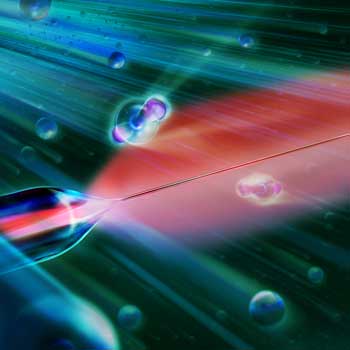| Feb 18, 2021 |
Nanofibers for quantum technologies at room temperature
(Nanowerk News) Atomic vapors are among the most promising platforms for constituting the nodes of future quantum networks. Researchers from the Weizmann Institute of Science together with colleagues from the Humboldt University of Berlin have now realized a unique interface between an extremely thin optical fiber and an atomic vapor at ambient temperatures.
|
 |
| Illustration of super-extended evanescent field of a nanofiber interacting with atomic vapor. (Image: Weizmann Institute of Science)
|
|
Efficient and faithful light-matter interaction lies at the heart of different quantum technologies. For example, the faithful mapping of information between matter and light can facilitate communication between distant quantum processing nodes. Strong interaction benefits from tightly confined light fields, as well as from a large number of atoms interacting simultaneously with such fields.
|
|
These two requirements, however, are hard to settle in a regular optical setup, in which laser beams can be focused only over a short distance and then quickly diverge. This divergence can be prevented by optical fibers, which also enable easy integration and scaling up of devices in optical networks.
|
|
In the new study (Optica, "Super-extended nanofiber-guided field for coherent interaction with hot atoms"), the authors study light fields guided by a new type of optical fiber and show that these fields interact efficiently with the vapor surrounding the fiber.
|
|
This efficient light-matter interface was realized by gradually thinning an optical fiber down to a diameter of 200 nm, about 600 times narrower than its original width, and about a quarter of the optical wavelength guided by the fiber.
|
|
Reaching these dimensions results in a unique optical field with more than 99% of the energy residing outside the fiber itself, extending far beyond its surface. Such a field allows a relatively long interaction time between the light and the atoms, even though the thermal atoms move rapidly across the field. The large ratio between the extent of the light field and the physical dimensions of the fiber also greatly reduces the detrimental effect of atoms interacting or colliding with the fiber itself.
|
|
This demonstration may pave the way for the realization of new, fully integrated, quantum technologies.
|

